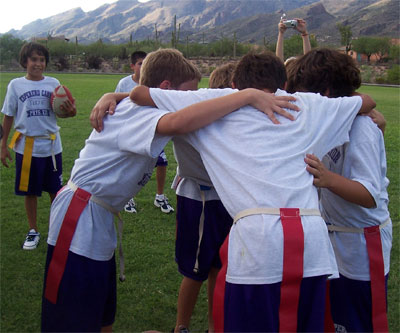
| Mission |
NYS Standards |
NASPE Standards |
Cirriculum |
Website Resource |
Community Information |
Physical Activity News |
Topic |
|
Middle
School
|
High School
|
 |
The acronym HELP is used to describe the philosophy of FITNESSGRAM and ACTIVITYGRAM:
Health and health related-fitness. The primary goal of both programs is to promote regular physical activity among all youth. Of particular importance is promoting activity patterns that lead to reduced health risk and improved health-related physical fitness.
Everyone. FITNESSGRAM and ACTIVITYGRAM are designed for all people regardless of physical ability. They are intended to help ALL youth find some form of activity that they can do for a lifetime. Too often activity programs are perceived to be only for those who are "good" rather than for all people.
Lifetime. FITNESSGRAM and ACTIVITYGRAM have as a goal helping young people to be active now, but a long term goal is to help them learn to do activities that they will continue to perform through out their lives.
Personal.
No two people are exactly the same. No two people enjoy the exact same
activities. FITNESSGRAM and ACTIVITYGRAM are designed to personalize
physical activity to meet personal or individual needs.
FITNESSGRAM was created in 1982 by The Cooper Institute to provide
an easy way for physical education teachers to report to parents on
children's fitness levels. Then and now, students are assessed in these
areas of health-related fitness: cardiovascular fitness, muscle
strength, muscular endurance, flexibility, and body composition. Scores
are evaluated against objective criterion-based standards, called
Healthy Fitness Zones, that indicate the level of fitness necessary for
health. FITNESSGRAM/ACTIVITYGRAM software generates the student and
parent reports, which contain objective, personalized feedback and
positive reinforcement. These reports serve as a communications link
between teachers and parents.
The Healthy Fitness Zone
standards were established by the FITNESSGRAM Advisory Board, which
includes some of the foremost scientists and practitioners in fitness
and physical activity. Technical information on the fitness assessments
and standards is available in the Reference Guide, which can be
accessed from the www.Fitnessgram.net home page, or from the Cooper
Institute Web site at http://www.cooperinstitute.org/products/grams/documents/FITNESSGRAM_ReferenceGuide.pdf.
FITNESSGRAM's Healthy Fitness Zones (HFZs) are research-based standards for aerobic capacity; body composition; and muscular strength, endurance, and flexibility. These standards indicate levels of fitness necessary for good health. They have been developed and refined over more than 25 years by the FITNESSGRAM Advisory Board.
A score in the HFZ represents the level of fitness thought to provide some protection from the potential health risks that result from a lack of fitness in this measure. The beginning of the HFZ represents a minimum level of fitness necessary to have acceptable health. These standards reflect reasonable levels of fitness that can be attained by most children that participate regularly in various types of physical activity. Because of this, we recommend that all students should strive to achieve a score that places them inside the HFZ. It is not uncommon for children to achieve the HFZ for some dimensions of fitness but not for others. Most children usually have areas that they excel in more than others.
Healthy Fitness Zones differ for boys and for girls, and they differ
based on age.
ACTIVITYGRAM is a physical activity assessment that is incorporated into the FITNESSGRAM software. It enables students to monitor and record their activity patterns over a three-day period, and receive a report that evaluates the results. ACTIVITYGRAM helps students learn more about their own physical activity habits, so they can more effectively plan personal activity programs to keep them healthy and active for a lifetime.
| Elementary | |
 |
|
| Middle School |
|
|
 |
| High School |
|
 |
|
| Teachers |
|
 |
| Locations |
Children |
Teens |
Adults |
 |
| New York Sports Club |
X |
X |
X |
|
| Bay Shore High School Track |
X |
X |
X |
|
| Gardners Park |
X |
X |
||
| Robert Moses |
X |
X |
||
| Armatras |
||||
| YMCA | X |
X |
X |
 |
-John
Little
|
Professional
Organitization
Websites
| National: American Alliance for Health, Physical Education, Recreation, and Dance. |  |
| State: NYS Assosication for Health, Physical Education, Recreation, and Dance |  |
| Local: Nassau Zone Suffolk Zone |  |